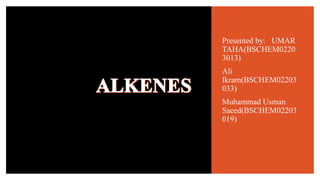
Preparation and Reaction of Alkenes
- 1. Presented by: UMAR TAHA(BSCHEM0220 3013) Ali Ikram(BSCHEM02203 033) Muhammad Usman Saeed(BSCHEM02203 019)
- 2. PRESENTED BY: UMAR TAHA BSCHEMO2203013
- 3. Alkenes Alkenes are hydrocarbons that contain carbon- carbon double bond. 01 General formula is CnH2n. 02 Unsaturated hydrocarbons. 03 Also called olefines. 04 Sp2 hybridized. 05
- 4. Preparation Of Alkenes: There are different methods pf preparation of alkenes given below; • By Dehydration Of Alcohols • By Dehydrohalogenation Of Alkyl Halides • By Dehalogenation Of Vicinal Di Halides • From Alkynes
- 5. By Dehydration Of Alcohols: • Dehydration means the removal of molecule water from a reactant molecule. • When an alcohol is heated in the presence of sulphuric acid, a molecule of water is eliminated, and an alkene is formed. R—CH—CH2 H2SO4 R—CH CH2 + H2O H OH heat
- 6. By Dehydrohalogenation Of Alkyl Halides: • Dehydrohalogenation means removal of the elements of hydrogen halides (H-X) from the adjacent carbon atom. • When an alkyl halides is heated with an alcoholic solution of sodium or potassium hydroxide, a molecule of hydrogen halide is eliminated, and an alkene is formed. H H H—C C H + NaOH alcohol CH2 CH2 + NaBr + H2O H Br heat
- 7. By Dehalogenation Of Vicinal Dihalides: • Dehalogenation involves the removal of a halogen molecule (X-X) from a reactant molecule. • A compound having two halogen atoms on adjacent carbon atoms is called a vicinal dihalide. • The treatment of vicinal dihalide with zinc dust using ethyl alcohol as a solvent, results in dehalogenation, and an alkene is formed. H H CH3 C C H + Zn ethanol CH3 CH CH2 + ZnBr2 Br Br
- 8. From alkynes: • Alkynes can be hydrogenated by using Raney nickel or finely divided platinum or palladium to give alkenes. R C C H + H2 Ni R CH CH2 +H2 R CH2 RCH3
- 9. Saytzeff rule: • A reaction that produces an alkene would favor the formation of an alkene that has greatest no substituents attached to the C=C group
- 10. PRESENTED BY: ALI IKRAM BSCHEM02203033
- 11. PHYSICAL PROPERTIES OF ALKENES: (BOILING POINT) - Most physical properties of alkenes are similar to those alkanes. - Example: the boiling points of 1-butene, cis-2-butene, trans-2-butene and n-butane are close to 0oC. - Densities of alkenes: around 0.6 or 0.7 g/cm3. - Boiling points of alkenes increase smoothlywith molecular weight. - Increased branching leads to greater volatility and lower boiling points.
- 12. POLARITY: • - relatively nonpolar. • - insoluble in water but soluble in non-polar • solvents such as hexane, gasoline, halogenated • solvents and ethers. • - slightly more polar than alkanes because: • i) electrons in the pi bond is more polarizable • (contributing to instantaneous dipole moments). • ii) the vinylic bonds tend to be slightly polar • (contributing to a permanent dipole moment).
- 13. REACTIVITY OF ALKENES: More reactive than alkanes because: • A carbon-carbon double bond consists of a σ and a π bond. It is easy to break the π bond while the σ bond remains intact. •The π electrons in the double bond act as a source of electrons (Lewis's base). Alkenes are reactive towards electrophiles which are attracted to the negative charge of the π electrons. • π bond will broken, each carbon atom becomes an active site which can form a new covalent bond with another atom. One π bond is converted into 2 σ bonds
- 14. PRESENTED BY : MUHAMMAD USMAN SAEED BSCHEM02203019
- 15. REACTION OF ALKENES: (Catalytic Hydrogenation) Addition of hydrogen to a double bond and triple bond to yield saturated product. Alkenes will combine with hydrogen in the present to catalyst to form alkanes. Platinum (Pt) and palladium (Pd) – Catalysts - Pt and Pd: temperature 25-90oC - Nickel can also used as a catalyst, but a higher temperature • of 140oC – 200oC is needed.
- 16. Addition of halogens in alkenes: A halogen addition reaction is a simple organic reaction A halogen molecule is added to the carbon– carbon double bond of an alkene functional group C=C + X2 → X−C−C−X (X represents the halogens bromine or chlorine, and in this case, a solvent could be CH2Cl2 or CCl4). The product is a vicinal dihalide.
- 17. Addition of hydrogen halides: • Addition reaction with electrophilic reagents. • - Alkenes react with hydrogen halides (in gaseous state or • in aqueous solution) to form addition products. • - The hydrogen and halogen atoms add across the double • bond to form haloalkanes (alkyl halides). • - Reactivity of hydrogen halides : HF < HCl < HBr < HI
- 18. MARKOVANIK RULE: • There are 2 possible products when hydrogen halides react with an unsymmetrical alkene. • It is because hydrogen halide molecule can add to the C=C bond in two different ways • The addition of HX to an unsymmetrical alkene, the hydrogen atom attaches itself to the carbon atom (of the double bond) with the larger number of hydrogen atoms
- 19. Addition reaction with concentrated sulfuric acid: hydration of alkenes • the alkene is absorbed slowly when it passed through concentrated sulfuric acid in the cold 0-15oC). • involves the addition of H atom and HSO4 • group across the carbon-carbon double bond. • - follows Markovnikov’s rule
- 20. ANTI-MARKOVNIC RULE: Peroxide-catalysed addition of HBr occurs through a free radical addition rather than a polar electrophilic addition - also observed for the reaction between HBr and many different alkenes. • - not observed with HF, HCl or HI. • combustion and oxidation follows anti- markonic rule